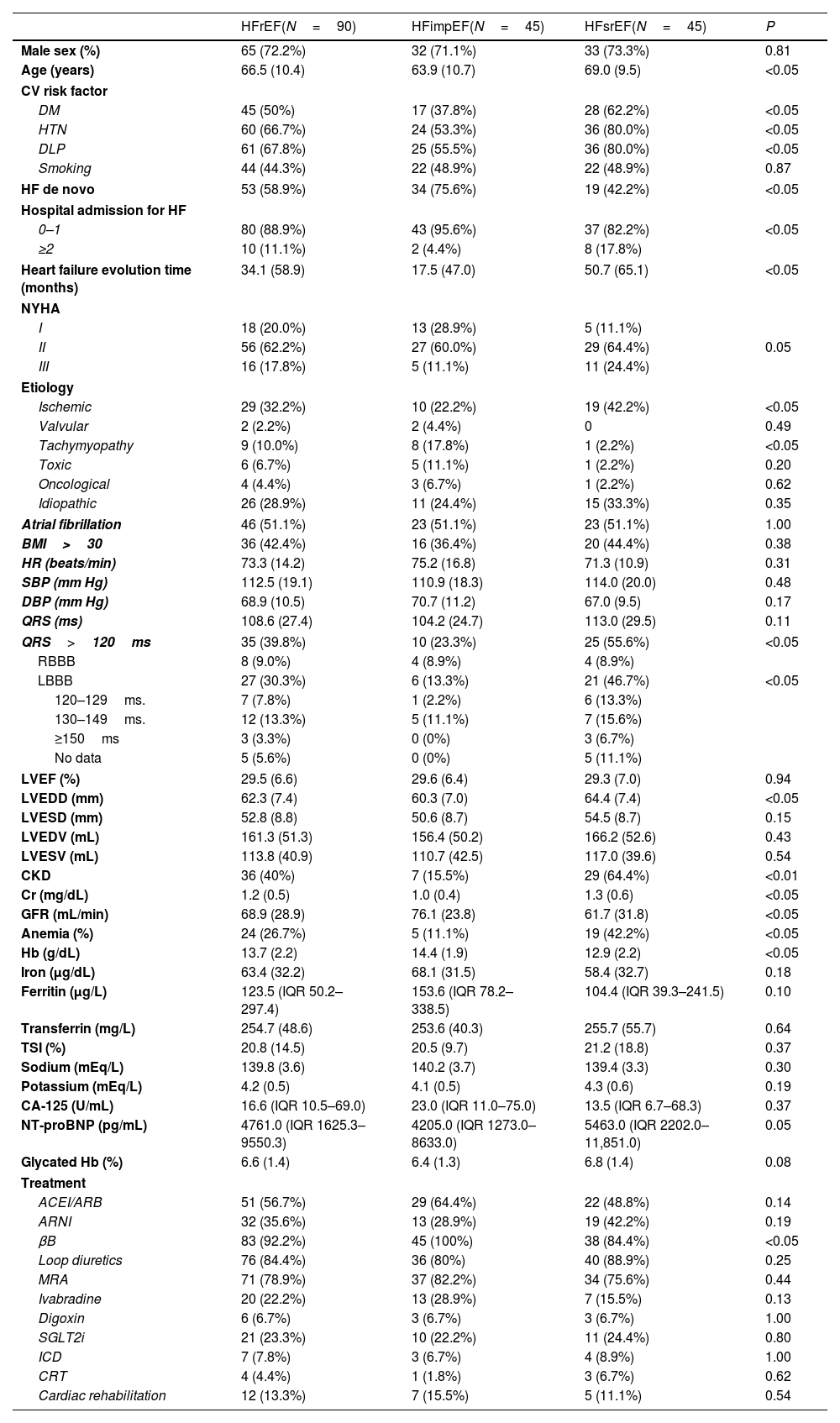A percentage of patients with heart failure with reduced ejection fraction (HFrEF) improve left ventricular ejection fraction (LVEF) in the evolution. This entity, defined for the first time in an international consensus as heart failure with improved ejection fraction (HFimpEF), could have a different clinical profile and prognosis than HFrEF. Our main aim was to analyze the differential clinical profile between the two entities, as well as the mid-term prognosis.
Material-methodsProspective study of a cohort of patients with HFrEF who had echocardiographic data at baseline and follow-up. A comparative analysis of patients who improved LVEF with those who did not was made. Clinical, echocardiographic and therapeutic variables were analyzed, and the mid-term impact in terms of mortality and hospital readmissions for HF was assessed.
ResultsNinety patients were analyzed. Mean age was 66.5(10.4) years, with a male predominance (72.2%). Forty five patients (50%) improved LVEF (Group-1,HFimpEF) and forty five patients (50%) sustained reduced LVEF (Group-2,HFsrEF). The mean time to LVEF improvement in Group-1 was 12.6(5.7) months. Group-1 had a more favorable clinical profile: lower prevalence of cardiovascular risk factors, higher prevalence of de novo HF (75.6% vs. 42.2%; p<0.05), lower prevalence of ischemic etiology (22.2% vs. 42.2%; p<0.05), with less basal dilatation of the left ventricle. At the end of follow-up (mean 19(1) months) Group-1 had a lower hospital readmission rate (3.1% vs. 26.7%; p<0.01), as well as lower mortality (0% vs. 24.4%; p<0.01).
ConclusionPatients with HFimpEF seem to have a better mid-term prognosis in terms of reduced mortality and hospital admissions. This improvement could be conditioned by the clinical profile of patients HFimpEF.
Un porcentaje de pacientes con insuficiencia cardiaca y fracción de eyección reducida (IC-FEr) mejoran la fracción de eyección ventricular izquierda (FEVI) en la evolución. Esta entidad se ha definido por primera vez en un consenso internacional como insuficiencia cardiaca y fracción de eyección mejorada (IC-FEm), y podría tener un perfil y pronóstico diferente que IC-FEr. Nuestro objetivo fue analizar el perfil de ambas entidades y su pronóstico a medio plazo.
Material y métodosEstudio prospective de una cohorte de pacientes con IC-FEr que tenían datos ecocardiográficos basales y en el seguimiento. Se hizo un análisis comparativo de pacientes con IC-FEm y pacientes con insuficiencia cardiaca y IC-FEpr. Se analizaron variables clínicas, ecocardiográficas y de tratamiento; el impacto clínico a medio plazo se analizó en términos de mortalidad y reingresos hospitalarios por insuficiencia cardiaca.
ResultadosSe analizaron 90 pacientes, edad media 66,5 (10,4) años (72,2% mujeres). La mitad de los pacientes mejoraron su FEVI, con un tiempo medio hasta la mejoría de 12,6 (5,7) meses. El grupo IC-FEm tenía un perfil clínico más favorable: menor proporción de factores de riesgo cardiovascular, prevalencia más elevada de IC-novo (75,6 vs. 42,2%; p < 0,05), y menor proporción de isquemia (22,2 vs. 42.2%; p < 0,05). Los pacientes con IC-FEm en el seguimiento a medio plazo tenían menor tasa de reingresos (3,1 vs. 26,7%; p < 0,01), y mortalidad (0 vs. 24,4%; p < 0,01).
ConclusiónPacientes con IC-FEm parecen tener un mejor pronóstico en términos de mortalidad y reingresos hospitalarios por insuficiencia cardiaca (IC). Esta mejoría clínica podría estar condicionada por el perfil de los pacientes con IC-FEm.











